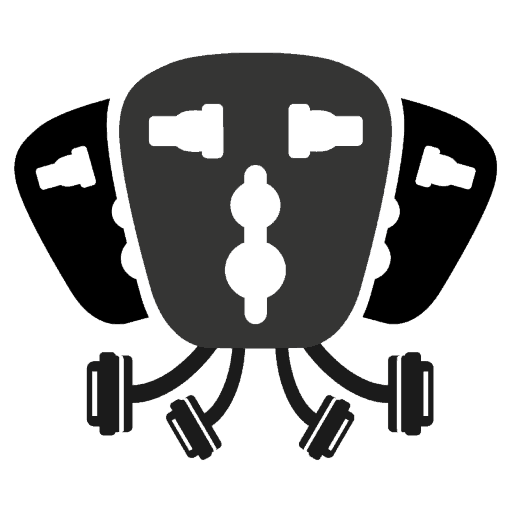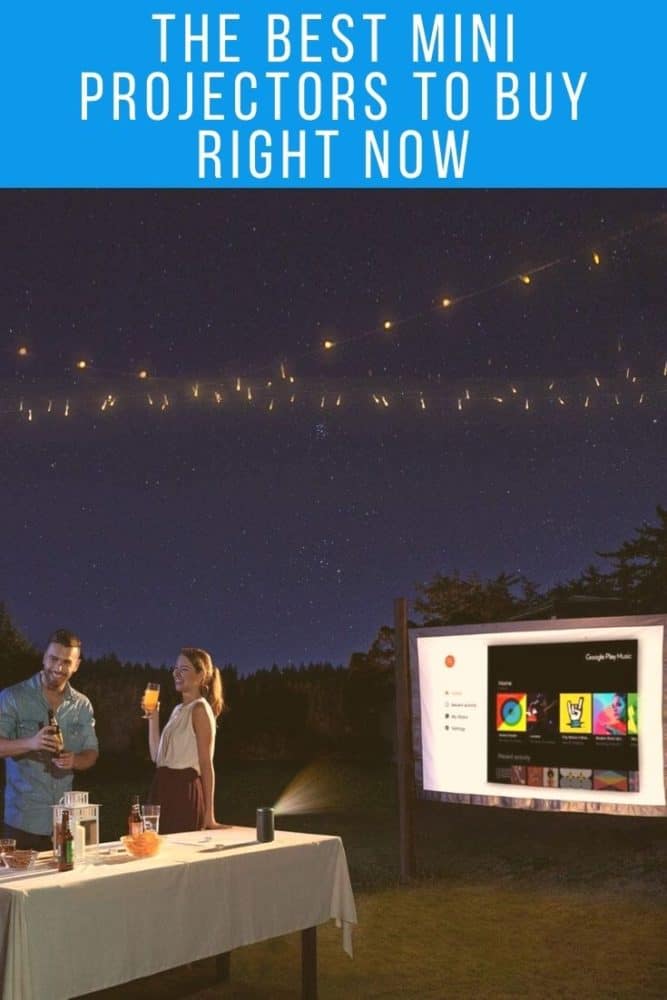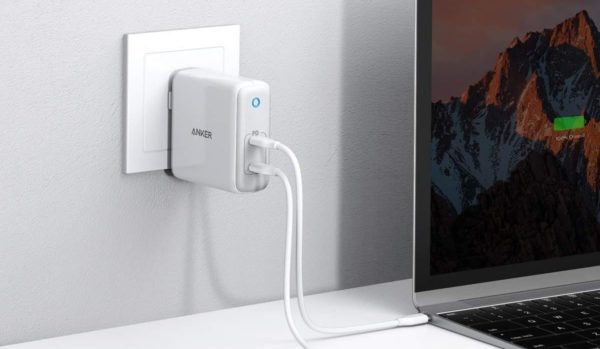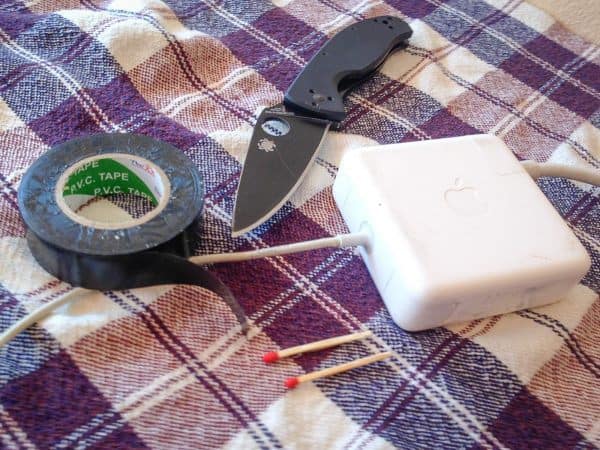The Best Mini Projectors Worth Buying in 2024
We may earn a commission from purchases you make after clicking links on this site. Learn more.Mini projector technology has vastly improved in the last few years, to the point where something that was long an expensive gimmick is now a sensible way of taking big-screen entertainment far beyond the confines of your living room.
Many companies now make compact devices that you can easily toss in your bag, providing a highly-portable projection system for camping trips, RV adventures, and backyard movies. This is exactly how I use mine: it just makes it much easier to watch something with my partner or a group of friends when using a TV isn’t an option.
The better models come with built-in speakers, decent battery life, and plenty of options for connecting smartphones, streaming devices, and gaming consoles: the more features you’re looking for, though, the more you’re going to need to spend.
When it comes to projectors, you really do get what you pay for. Budget at least a couple hundred dollars for anything worth buying, and more for higher resolution and better brightness. Try not to get too carried away, though: don’t pay more for features you’ll never use.
These are the mini (or pico) projectors I’d recommend to my friends and family at the moment, along with what’s not worth the money, and advice on how to navigate complicated product descriptions. Things are not always as they seem when it comes to resolution and brightness in particular!
- Dimensions: 6.3 x 4.7 by 4.3 inches (16.1 x 11.9 x 10.8cm)
- Weight: 2.4 pounds (1.1kg)
- Battery: none
- Native Resolution: 1080p (1920 x 1080)
- Brightness: 400 ANSI lumens
- Dimensions: 3.3 x 3.3 x 6.7 inches (8.4 x 8.4 x 17cm)
- Weight: 33oz (935g)
- Battery: 15000mAh - up to 2.5 hours (video), 8 hours (music)
- Native Resolution: 1080p (1920 x 1080)
- Brightness: 300 ANSI lumens
- Dimensions: 6.9 x 4.8 x 1.4 inches (17.5 x 12.2 x 3.6cm)
- Weight: 27.5oz (779g)
- Battery: 5200mAh - up to 2 hours
- Native Resolution: 1080p (1920 x 1080)
- Brightness: 400 ANSI lumens
How to Choose a Mini Projector
Portability
One of the most important aspects of a portable projector is, well, it’s portability. There’s always going to be a trade-off between size and performance: the smaller the projector is, the less room there is for batteries, lamps, and speakers, and the harder it is to get rid of the heat they create.
For some people, having a slightly larger model isn’t the end of the world. If you’re only carrying it to and from your vehicle or into the backyard, a pound of extra weight doesn’t really matter, especially if it saves money or gets better performance as a result.
If you’re hiking into a campsite or trying to fit the projector into a backpack or suitcase, however, size and weight are going to be key concerns.
Don’t just consider the size of the projector itself: factor in any cables, tripods, and external speakers you also need to bring with you. If you’re looking for a projector to use while camping trips or in other off-grid spots, make sure it has a built-in battery so you don’t need to rely on an external power source.
Battery Life
Speaking of built-in batteries, they’re not all created equal. For most of us, how long a projector lasts away from a power outlet defines how portable it really is.
A mini projector set at its highest brightness consumes more battery, with better ones likely lasting at least the length of a short movie (around two hours). Some models claim they can project for anything up to twice that, but that’s typically only achievable in lower brightness modes.
That might be fine if you’re in the middle of nowhere with very little ambient light, but for daytime viewing or competing with streetlamps, you’ll need the crank up the brightness to maximum.
If you want to watch movies all night, I’d suggest getting a mini projector that charges via USB C and can run from an external power bank. This way, you can keep the party going as long as you want without worrying about your projector dying halfway through your movie marathon.
If you’re going to do this, just check the minimum power requirements for the projector and the maximum output of the power bank. You’ll likely be fine with something like this high-capacity version that can put out up to 65W, but again, just check the specs of the projector you plan to buy.
Some projectors omit the battery entirely, requiring an external power source to function. That’s fine if you know you’ll only use it within easy reach of an extension cord, or are happy to always use a power bank. If that’s not the case for you, though, look for one with an inbuilt battery.
Screen Size and Resolution
A projector’s screen size refers to how large an image it can display, typically measured in inches across the diagonal. All of my recommended options support a screen size of 60″ or more (often, much more), but remember that for any given projector, the larger the screen size, the dimmer and less sharp it will be.
Resolution claims for projectors get a little tricky to navigate. HD (high-definition) refers to a resolution of 1280 x 720 pixels, while Full HD (FHD) is 1920 x 1080 pixels. The difficult part is that most projectors have two resolutions, native and maximum, and the difference is important.
The native resolution refers to the physical size of the projection panel. The bigger it is, the higher the quality of the image at a given size. Using software, all projectors can scale an image up from their native resolution to a maximum of HD or Full HD, but the more scaling that’s happening, the worse the image will look.
If you’re scaling from a native resolution of 320 x 240 pixels to FHD at 100 inches, for example, don’t expect to enjoy the viewing experience. Product descriptions are misleading, especially for lower-cost units. They’ll make you think you’re purchasing a Full HD projector, but unless that’s the native resolution, you’re not. Pay attention to the fine print.
All of the projectors I recommend below are true FHD; you pay slightly more for this level of picture quality, but your eyes will thank you for it. I don’t really see the point in watching a blurry, pixelated movie just to save a few bucks.
Lumens
The brightness of a projector is measured in lumens, a measurement of the total amount of light visible to the human eye from a light source. An ANSI lumen is a standardized measurement that quantifies the overall brightness or light output of a projector.
The higher the number, the brighter the image will be. 400 ANSI lumens is good for a large room, for example, while 100 ANSI lumens is only suited to a smaller space.
Just to complicate things further, the light from a projector’s light source dims considerably on its way through the projector. On average, the ANSI lumen value of the projected image is often only about 30% of the value at its light source.
Some brands only advertise the lumen value of their projector’s lamp, and don’t clarify the difference. If you see a mini projector boasting 4000 lumens, it refers to the light coming from the bulb, not the brightness of the projection.
All of the projectors below are 300-400 ANSI lumens, which is about as good as it gets with a portable projector at the moment. While that’s still not enough to project a watchable image in broad daylight or a well-lit room, you’ll at least get a big, bright picture once night falls.
Ease of Use
It’s important to find a projector that’s easy to set up and use. The last thing you want is to be fumbling around with cords and figuring out the interface when you’re trying to enjoy a movie.
Some projectors come with an auto-keystone feature that automatically adjusts the image so it’s rectangular, even if the surface you’re projecting on is angled or curved. It can be a lifesaver when you don’t have a perfectly level surface to work with, or are projecting from well below your viewing area.
Another thing to look for is an auto-focus that works flawlessly, or a focus ring around the lens that lets you manually adjust the focus until the image is clear. Stay away from mini projectors that have fixed-focus lenses where possible, since the only way to change the focus on these is to physically move the projector.
While a remote control isn’t strictly necessary, it can certainly be useful when you’re trying to adjust the settings from across the room. Many models also have an app that you can download to your phone, so you can control the projector from there instead.
Sound Quality
Some of the better mini projectors have built-in speakers that deliver pretty reasonable audio, at least if you’re sitting fairly close to the projector or are in a quiet space. Others definitely do not, especially at the low end of the range.
When looking at speaker specs, consider both the output wattage and the number of speakers. The higher the wattage, the louder your projector can get, while multiple speakers usually means better, stereo sound. A decent product has at least 3W dual stereo speakers, for instance. More is definitely better.
There are limits to how loud the speakers will be on any mini projector, however, and even with better models, many people end up connecting external speakers (wired or wireless) for better audio. If you’re okay with carrying around an extra Bluetooth speaker, look for a projector that also has Bluetooth for easier connection.
Some of the higher-end models also have HDMI ports that mean you can directly connect them to a soundbar. You’ll also find audio sockets on some projectors, so if your speaker has a line-in option, you can run a normal analog cable between them.
Throw Distance and Throw Ratio
The throw distance is the distance between the projector and the screen or surface you’re projecting on. The image will be larger or smaller depending on how far away you place the projector.
For a mini projector, a short throw distance is ideal, since it gives you more flexibility in where you can set up your device. A projector with a long throw distance is better suited to large rooms, since it needs to be further away from the screen to produce a large image.
Note that the resolution and brightness of the projector will limit how far you can place it from the surface you’re projecting onto. The closer it is, the smaller, brighter, and sharper the image will be. Check the manufacturer’s recommended (not maximum) viewing distance in the product description.
Relatedly, throw ratio refers to the size of the projected image compared with how far the projector is sitting from the wall or screen. A common ratio is 2:1 — this means that for every two feet (or meters) of distance from the screen, you’ll get one foot (or meter) of projected image.
Using these two measurements, you can figure out whether you’ll be able to get a large-enough image for your requirements from any given projector.
Connectivity and App Integrations
Regarding connectivity, the options include HDMI, Bluetooth, and various USB ports. Your particular requirements (especially around streaming from other devices) will determine which of those is a must-have, and which aren’t so important.
Most projectors have an HDMI input, which is the standard for high-definition video and audio. Some also come with an HDMI output, which lets you daisy-chain multiple projectors together or connect the projector to a TV or monitor.
If there’s a USB C socket on the projector and you plan to use it, check whether it supports both charging and streaming video, or just one or the other.
While some models have both USB C and HDMI ports, others might only have one or the other. With the right cable, you may be able to stream from your laptop to your projector via either option: just check in advance to make sure that the projector you’re considering is compatible with your devices.
If you have MP4 or other video files available, you may also be able to copy them to a USB stick and play them directly from your projector. This is typically done via a USB-A or USB C port, so confirm there’s one available on your chosen projector if this is something you plan to do.
In addition to physical ports, some projectors also offer app integrations like Netflix and Apple TV. In the last year or two, many companies have started using Android TV as the operating system, making the projector work almost exactly the same as a modern smart TV, with all of the apps that come with that.
This is super-convenient, but obviously requires a stable, fast internet connection to use. Streaming directly from your projector like this, combined with using Wi-Fi, will also drain your battery more quickly than doing it offline via a cable or USB stick.
Wireless streaming via Miracast or AirPlay is also an option. It avoids the need for extra cables, but is only available with certain devices, and will reduce the projector’s battery life as well.
What to Avoid
Mini projectors are meant to be portable, so you’ll want one that’s easy to transport, doesn’t need a lot of setup or accessories, and has decent battery life. Any product that can’t provide those three things requires a compromise of some sort, so pass on it unless you know that aspect doesn’t matter to you.
For example, some projectors require an HDMI cable to connect to a laptop, while others can do it wirelessly. The former means keeping track of yet another cord, while the latter limits the devices you can use your projector with.
As for the size, anything larger than a shoe box pushes it. Larger projectors may have better features, but they’re less convenient to store and transport. If you’re looking for a projector to take camping or backpacking, make sure it’s small and light enough that it won’t add too much weight to your bag.
Finally, some mini projectors have excessively loud fan noise when they get hot, making it difficult to hear audio from the built-in speakers. If you’re looking for a projector to use in quiet environments like an office or bedroom, be sure to check how noisy the fan is before making your purchase.
How Much I Should Spend?
When it comes to cheap mini projectors, my advice is simple: don’t waste your money on super-budget versions. Plan to pay somewhere around $150-250 at a minimum, as spending less just means poor durability and lower quality video. That’s especially true when you make the picture large enough for multiple people to view.
Cheap projectors that boast HD quality projection are misleading. For example, the Fosa Mini Projector says it’s an HD projector supporting 1080p, but the device’s native resolution is 320 x 240 pixels. That’s a huge difference, one that your eyes will definitely notice.
Spend a bit more on one of the models we mention below, and you’ll get a better device: brighter, with longer battery life, a clearer picture, and a better interface. Yes, they’re more expensive, but you’ll be much happier with the end result.
Best Mini Projector: XGIMI MoGo 2 Pro

It’s hard not to like XGIMI's MoGo 2 Pro mini projector, even if you’ve never heard of the brand before. Its impressive specifications, strong performance, and reasonable price make it very easy to recommend, and it’s the best mini projector option for most people.
The 400 ANSI lumen brightness is top of the line when it comes to portable projectors, and means you’ll have a good chance of being able to see what’s going on even when there’s a bit of ambient light. Higher contrast and darker blacks help as well, leading to a better viewing experience overall.
There are a few viewing presets built into the projector, and create an acceptable image in most cases. While you’ll rarely need to manually alter the contrast or brightness levels or tweak the color temperature or white balance, the option is there if you need it.
As with the brightness, the FHD (1080p) resolution is as good as it gets with portable projectors at the moment. In a dark viewing environment, you can expect the image to be sharp and detailed, with rich, saturated colors, up to about 70″. Both focus and vertical keystone correction are automatic, happening whenever you move the projector.
The MoGo 2 Pro has Android TV 11 built in, with the simple interface and large app selection that comes with it. If you’re too far from a Wi-Fi signal to stream your movie or show, you can plug in a USB stick instead, or connect a laptop or tablet to the HDMI port on the side.
The 8W stereo speakers are impressive for a speaker this size, putting out enough volume to be easily heard in a quiet-ish environment and sounding pretty good when they do. You can plug in a set of external speakers as well if you’d prefer, or connect a Bluetooth version instead.
The biggest downside as far as real portability is concerned is the lack of an internal battery. Yes, you can run it from a USB C power bank (you’ll need one like this that can put out 65W), but that’s obviously something else to buy and carry.
Failing that, it’ll need to be plugged into an outlet. For some people that won’t matter, since you’ll be using it indoors, in a powered RV, or at least within range of an extension cable. If that’s not how you plan to use it most of the time, though, you’ll be better off with the Nebula Capsule 3 Laser I talk about below.
Given that lack of battery, I’d have expected the projector to be a bit smaller and lighter than it is. While no means bulky, it’s still larger and weighs more than the Capsule 3; something to bear in mind if you need to carry it in a backpack for any distance.
The biggest upside, of course, is the price. Being able to pick up a bright Full HD portable projector with good sound and no major problems for under $500 is remarkable, and means that while this projector isn’t perfect, it’s about as close as you’ll get for the money right now.
Pros
Cons
Best With Battery: Nebula Capsule 3 Laser
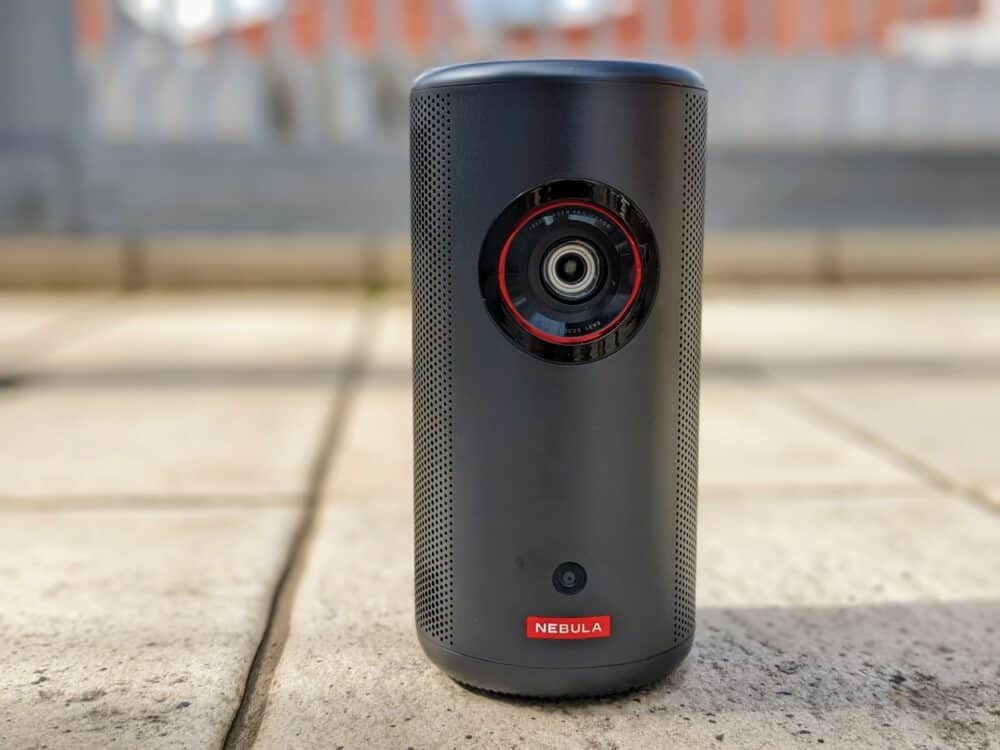
As I mentioned earlier, while the MoGo 2 Pro will be the best option for many people, it’s not the right choice for everyone. If you know you’ll mostly be using your projector away from a power source, the lack of an internal battery gets old pretty quick.
That’s where the Nebula Capsule 3 Laser comes in. This is the model I drop in my bag whenever I’m going somewhere without a power outlet, whether that’s a remote campsite or just down the end of my backyard.
It’s relatively small and sturdy, and while I think Anker’s marketing campaign that likens its size to a tall can of beer is perhaps a little optimistic, the cylindrical shape and lower weight certainly makes it better in a backpack than the cube-like MoGo 2 Pro.
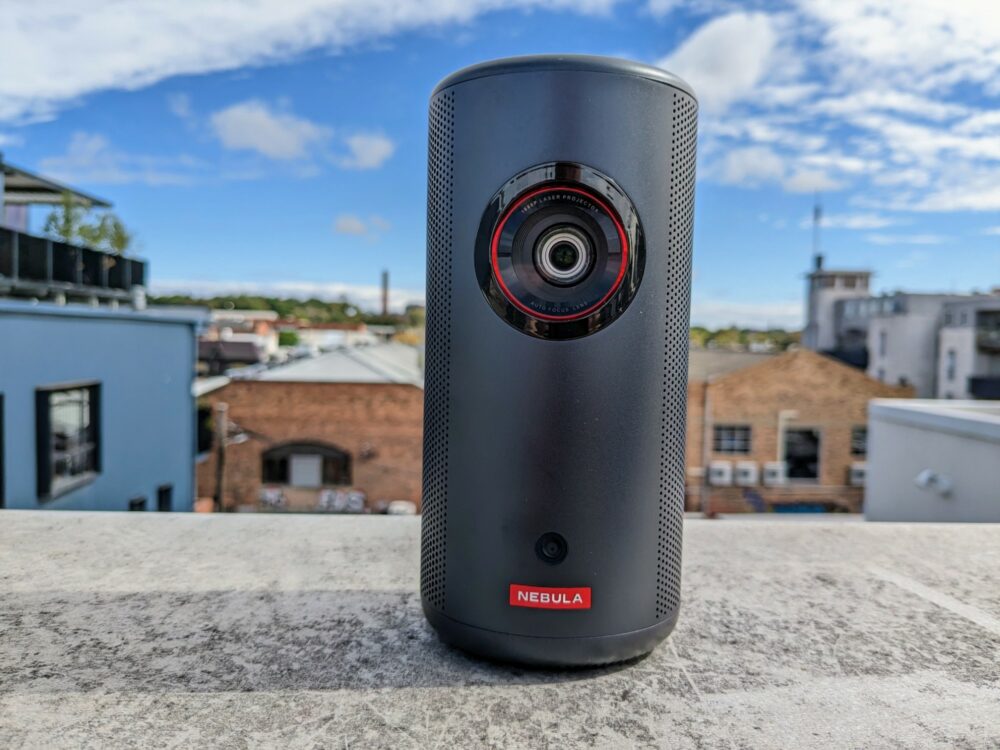
Back in 2017, Anker raised over a million dollars on a crowdfunding campaign for the original Nebula Capsule, and basically invented a new category of powerful mini projector that you’d be happy to use in your spare room or backyard, but still take on road trips, camping, or backpacking adventures.
This third iteration continues to improve on the original design, with more connection options, higher resolution, and a brighter image. The Capsule 3 projects a native 1080p resolution with 300 ANSI lumens of brightness at up to a 120” display. That’s not quite as bright as the Mogo 2 Pro, but it’s still pretty good for a device this small and portable.
The roughly 2.5-hour battery life has been enough to get me through most movies without needing a power source, and I’ve usually found the pair of 8W speakers to be loud and clear enough even outdoors. On the odd occasion I need even more volume, I just connect a Bluetooth speaker: lately I’ve been using the company’s Motion 300 for this, and it works well.
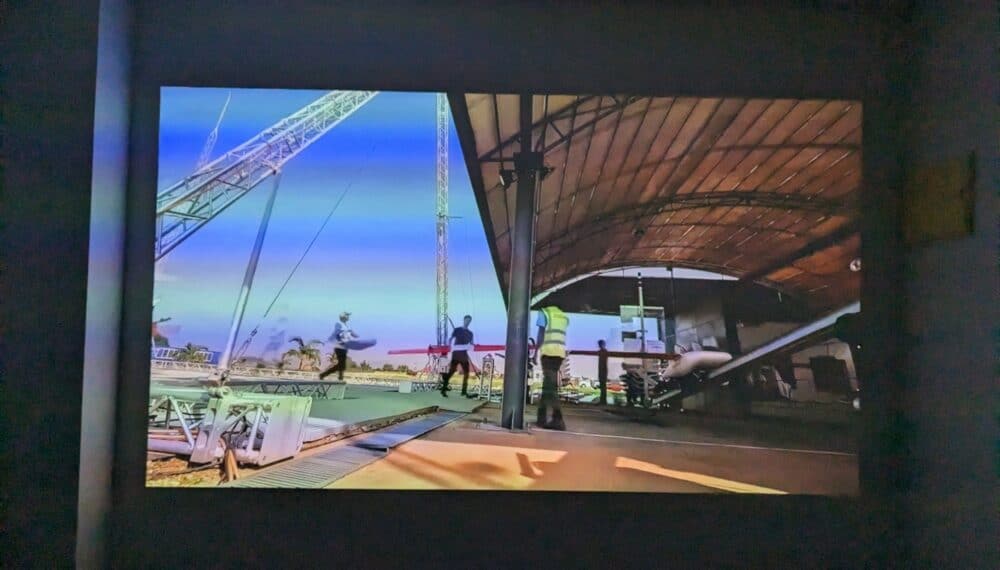
It runs on Android TV 11: as with the Mogo 2 Pro, that provides access to thousands of games and apps, including Hulu, YouTube, Amazon Prime, and (if you’re happy to follow the instructions for sideloading), Netflix.
You can connect also connect physically with HDMI and USB, or wirelessly through Wi-Fi, Bluetooth, or Chromecast. I’ve used them all at different times, mostly because often when I don’t have power, I don’t have an internet connection either.
I reviewed the Nebula Capsule 3 Laser in depth in the middle of last year, and have used it regularly ever since: my comments from that review still stand. With similar specs and more features than the Mogo 2 Pro, it was a very close race between the two as to which was going to be my top pick.
In the end, the cost saving of the Mogo 2 Pro outweighed its lack of battery, but as I say, the Capsule 3 Laser will still be the better choice for some people. If you know the way you’ll use the projector justifies the extra cost, you’re not going to be disappointed here.
Pros
Cons
Best for iPhone: Miroir MP289

Apple has paired up with projector manufacturer Miroir to sell small versions designed for use with iPhone, iPad, MacBook, and Apple TV. As long as you have one of Apple’s Lightning to AV adapters, you’ll be all set to project directly from your mobile device.
The Miroir HD Mini Projector MP289 is a compact projector, although at 6.9 x 4.8 x 1.4″ and 27.5oz, it’s not the smallest on this list. Even so, it’s lightweight enough to justify dropping in an overnight bag without having to leave anything else important behind.
The MP289 has a 1080p native resolution and projects at an impressive 400 lumens. Able to display up to a 100″ screen, it connects to whatever streaming media players you prefer through its HDMI port, as well as streaming content directly from your iPhone or iPad via apps on the device.
The built-in battery provides up to two hours of projection time, and the 2x two-watt speakers are fine for indoor use. If you’re watching something outside or with a group of people, you can connect more powerful speakers via the 3.5mm audio jack.
Pros
Cons
Final Thoughts
A good mini projector is an investment, so plan to spend $250 or more to get something worthwhile, and two or three times that for a model with enough brightness and resolution to watch with multiple people.
If they’re within your budget, the XGIMI MoGo Pro 2 or Nebula Capsule 3 Laser are very much the way to go. Easily the best all-round options, they’re compact and portable with bright, clear pictures, decent sound, and strong compatibility with other devices.
Main image via Shutterstock, Mogo and Miroir product images via Amazon, photos of Nebula Capsule 3 via author
